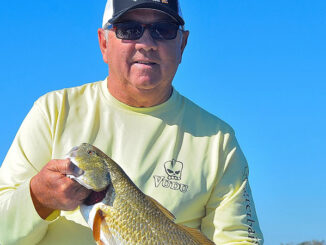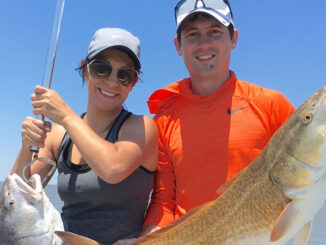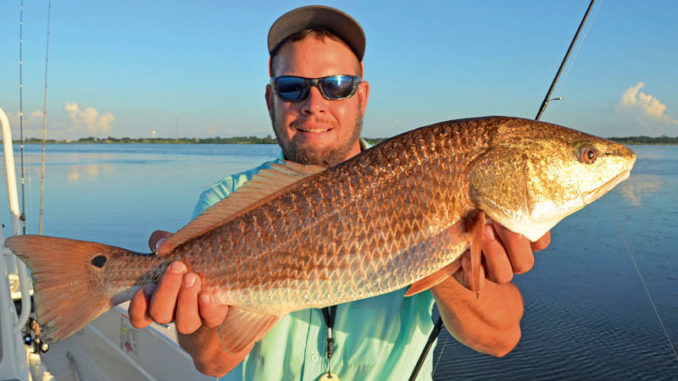
Hit the schools as giants bull their way through shallow bays
Bull redfish spend most of their time offshore, but when preparing to spawn, giants move closer inshore. In the spring and from late summer into fall, giant redfish gather in large, marauding schools that go on a ruthless rampage through the shallow bays along the coast eating everything they can catch and swallow.
“In April, the big reds are full of eggs,” said Tommy Pellegrin of Custom Charters (985-851-3304, www.Customchartersllc.com) who fishes out of Cocodrie in Terrebonne Parish. “Schools gather in the cuts and passes at the southern end of Terrebonne Bay and Lake Barre. Any place with a tidal drain cutting through an island would be a great place to fish. In the spring, look for bulls around Beach Point, Whiskey Pass, Little Pass and at the extreme eastern end of Timbalier Island.”
Many waters, such as Lake Barre, Lake Pelto and Lake Raccourci, all merge together with Terrebonne and Timbalier Bays between Cocodrie and Fourchon. Several barrier islands demarcate the boundary between the inland waters and the Gulf of Mexico.
Finding the islands
One of the largest barrier islands, Last Island, or Isles Dernières in French, once stretched about 25 miles across the southern part of Terrebonne Bay and Caillou Bay. Over the years, hurricanes battered the islands and chopped some in half, hence the use of the plural “Isles” Dernières. Today, some only remain as outcroppings, sandbars or reefs. Many islands disappeared entirely and now exist only as names on old maps, but they still offer structure that attract fish.

“We lost numerous islands over the years from erosion,” said Kip Plaisance (985-637-7251, fishtidewater.com), who guides with his son Max for Plaisance’s Tidewater Charters out of south Lafourche Parish. “The lakes and bays all run together between Port Fourchon and Cocodrie. I remember years ago, when the lakes and bays were somewhat separated. People who know where those islands used to be can still catch fish around them.”
Fish congregate around points on the islands, in the passes or in deeper troughs along the beaches — wherever they can ambush bait. When fishing a beach, always look for something different in the bottom contour. Anglers can also fish numerous wellheads dotting the area. These frequently hold big fish all year long.
“On a calm day, we cruise the beaches by Last Island or Timbalier Island and see a lot of redfish,” Pellegrin said. “Early in the morning, look for birds diving on bait. When big redfish gather in schools, they will eat anything. April is an awesome time to fish topwater baits.”
The biggest reds want a substantial fishy meal and particularly crave succulent mullets. Many topwater baits mimic crippled mullets. Probably nothing creates more excitement for inshore anglers than a monster redfish exploding on a big topwater bait.
Try topwaters
Walking baits, such as the Top Dog family of lures, Rapala Skitter Walks, Heddon Spooks, Berkley J-Walkers and HighJackers, move across the surface with a scintillating zigzag motion like a crippled mullet. These hefty baits sail long distances and cover water quickly, making them excellent search baits. Toss a big topwater in front of a moving school. Flick it a couple times and hang on!
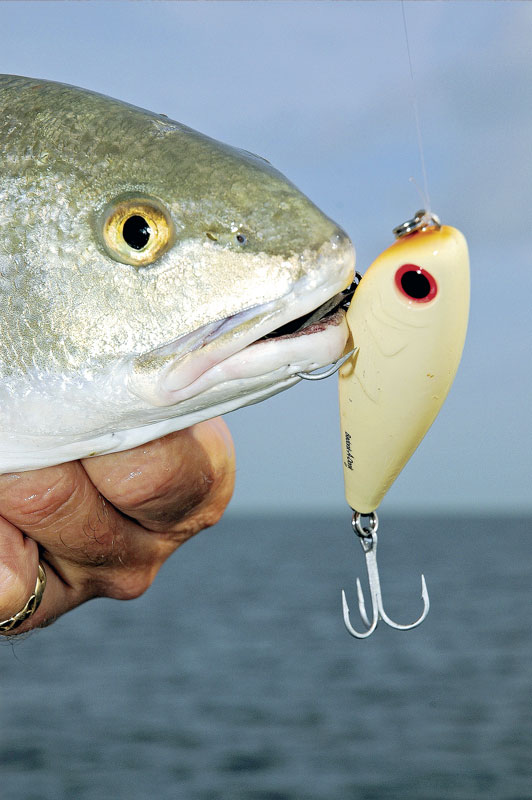
“Once we get our limit of bulls, sometimes we throw topwaters without hooks just to watch redfish annihilate the lures,” Pellegrin said. “They will pull some drag until they spit out the lure. If one spits out the lure, we often get a strike from another bull. Sometimes, we’ll get five or six strikes per cast. That’s exciting.”
Besides topwaters, many anglers throw spinnerbaits, gold spoons and jigheads sweetened with soft-plastic temptations at reds. For the big bulls, use large trailers that mimic baitfish
When all else fails, offer the vicious predators meat. On a Carolina rig tipped with a circle or kahle hook, put a live mullet, croaker or pogie. Fish chunks and whole crabs or halves also entice bulls. A circle hook catches fish in the corner of their mouths, making releasing them easier. A fish caught on a circle hook will more likely survive than one that swallows a bait.
“For bulls, we typically fish a 2-ounce weight on a Carolina rig with a 5/0 to 7/0 kahle hook,” said Tim Ortego with Louisiana Livin’ Adventures (985-209-1812, www.capt-tim.com), who runs out of Coco Marina, (cocomarina.com) in Cocodrie. “We cut a crab in half and leave the top shell on to prevent catfish and other small fish from eating too much of it. I crack the top shell so the smell can ooze out. When catfish aren’t too numerous, we use whole small crabs hooked by the swimmer fin and out the bottom.”
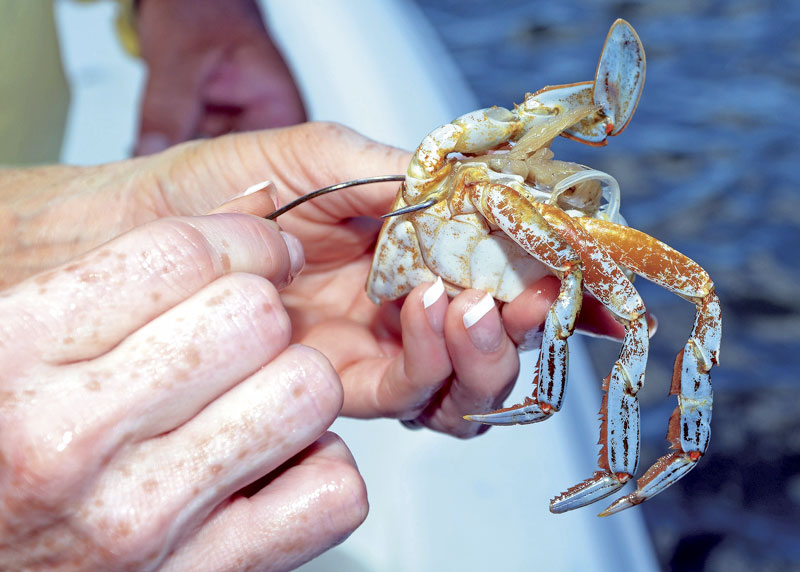
Meat in the box
For putting more meat in the box, hit the marshes for slot redfish. Juvenile reds live in the marshes all year long. By April, any marshy ponds should hold redfish.
“April is one of the best months to catch redfish in the marshes around Terrebonne Bay,” Ortego said. “The fish get more active as the water warms. Once the water gets up to about 70 to 75 degrees, that’s prime time to catch slot redfish in the Terrebonne-Lafourche marshes. Fish that haven’t been as active during the winter are hungry and looking for food. Look for reds in the interior marshes around Madison Bay, Wonder Lake and all around the Pointe Aux Chene areas.”
East of Leeville, fish Lake Pierre, Bay Rambo, Palmetto Bayou and the marshes around Hackberry Bay. West of Leeville, the marshes surrounding Catfish Lake hold good fish. Other good places to fish include the Sister Lake, Lake Mechant, Lake Felicity and Lake Tambour areas or the canals around Lake Boudreaux off Bayou Caillou Bayou and Grand Caillou Bayou. Also fish Oyster Bayou and Lost Lake.
For catching slot reds, use the same baits that tempt bulls. Just downsize the offerings a bit. Flickering spinnerbait blades and bladed jigs give off vibrations and flash that simulate small swimming crabs. Redfish can’t resist small crabs. Use baits with a little blue on them to duplicate the color of crab claws.
“In the spring, redfish really go for bladed jigs, like a ChatterBait,” Plaisance said. “For slots, I like to throw spinnerbaits. With bladed jigs and spinnerbaits, I always want a gold blade. For the body, I like blue and white with a little chartreuse. My favorite way to catch reds at that time of year is with a shallow-running crankbait like a Mann’s Baby 1-minus. Bait is small in the spring so use smaller lures. In clear water, use natural colors. In murky water, throw brighter colors, like something with a little chartreuse on it.”
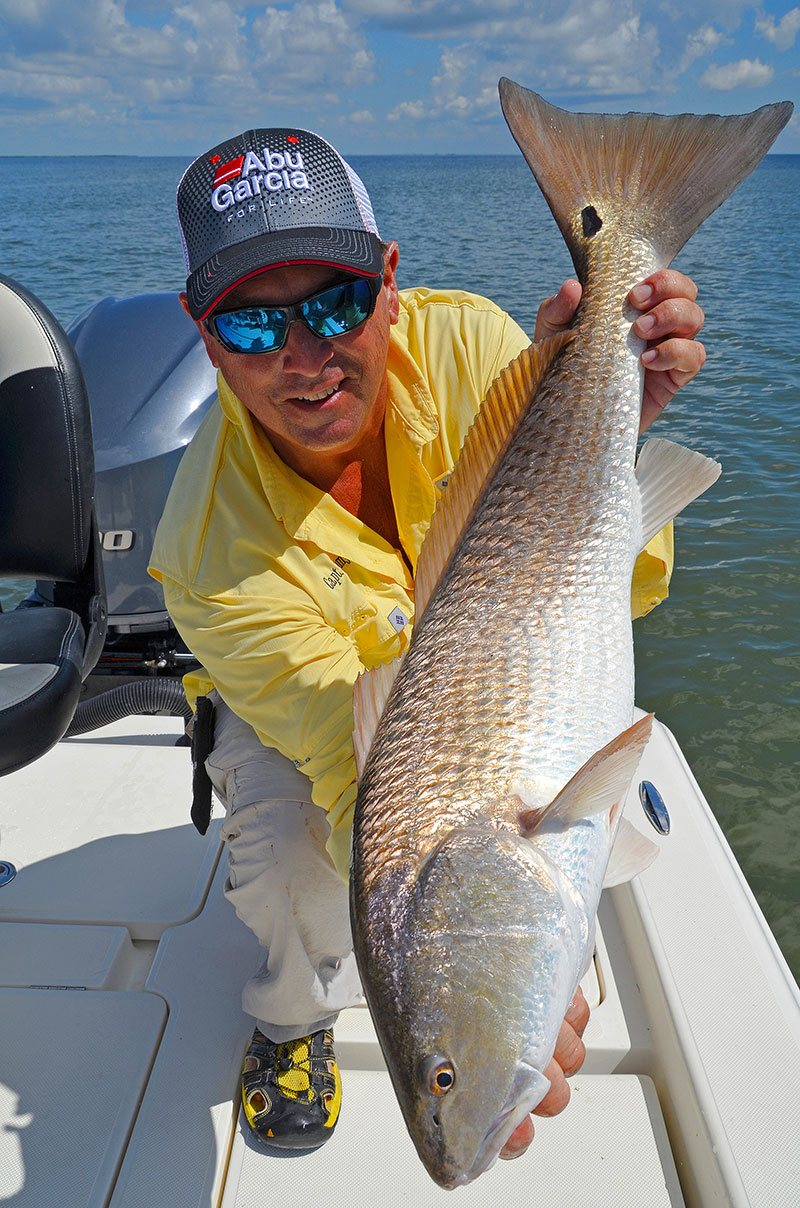
The transformer
Many anglers use live shrimp or cocahoe minnows dangled under a popping cork. Other natural baits, fished either under a cork or on the bottom, also work for reds. In dingy water, market shrimp gives off a good odor that redfish can find. Crab pieces attract any redfish’s attention.
“My favorite bait is a Transformer Shrimp,” Pellegrin quipped. “That’s a live shrimp that we throw out in the water. When we bring it back to the boat, it transforms into a redfish or a speckled trout. Call Outlaw Baits in Cocodrie and ask for Transformer Shrimp.”
When fishing the shallow marshes, keep quiet. Avoid banging locker lids or stomping around in the boat. Any vibrations transmit through the boat hull into the water and fish can detect it. That could spook fish.
“Stealth is the key to catching redfish in the shallow marshes,” Plaisance said. “Catching redfish is kind of like hunting. We have to find them first. Once we find them, we can catch them. When it’s hungry, a redfish will eat just about anything that passes in front of its face. Don’t run up on a spot with the big engine. Get close and creep up to it with the electric motor. When we get to a good area, we drop the Power Pole to hold the boat in place. We’ll fish a spot for a while and then move down the bank a little to fish another spot.”
Any tidal movement, incoming or outgoing, moves bait and stirs up predators. During a rising tide, anglers can more easily get into the shallowest, rarely fished ponds. Dropping water pulls baitfish, shrimp, crabs and other tasty morsels from the marsh ponds into deeper channels. Facing into the flow, redfish and other species wait at the drain mouths for the tide to deliver them something to eat.
“When fishing the marsh, we look for any type of current,” Ortego said. “We fish all the drains and cuts coming out of the marshes. We also look for clear water and bait. Points are another good place to fish. We also look for pockets and little breaks in the banks. Those are key areas.”
Redfish regularly congregate in numbers. Where one feeds, several could gather. Hungry, redfish commonly try to snatch baits from the mouths of their brethren. If someone hooks a redfish, others should toss a bait close to that fish and possibly land a double or even a triple.
